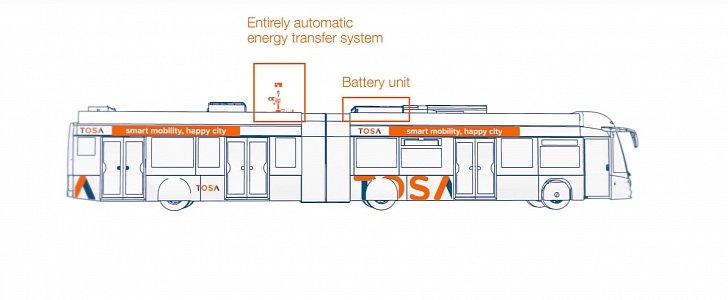Why bother with electric buses when we already have means of public transportation that are 100 percent electric and can go on indefinitely? In case you're wondering, they're called trams (streetcars), trains or subway, and they do the job just fine.
Well, all three mentioned above - as well as the trolley buses that have somehow missed the list - have one thing in common: they are constrained to a specific route dictated by the tracks or the overhung wires. That means they require a significant investment in the initial infrastructure, but also that they don't provide too much flexibility.
ABB, a Swiss rail and bus company, has been proposing a different solution. Instead of having the electric vehicle in constant contact with a power source, it proposes equipping said vehicle with a specially-designed battery pack and allowing it to charge for very short periods of time that would not disrupt the route at specific intervals.
In plain English, the electric bus would charge for about 15 seconds as the passengers get in or out during a stop, receiving enough power to keep going for the next three to four stops. At the end of the line, the bus would have the time to recharge for a few minutes, replenishing its energy stocks and getting ready for another go.
ABB has been demonstrating this idea for the past year, but it has now secured a commercial contract and hopes to sell the technology to other countries around the world. For now, though, its TOSA articulated e-buses will be running on Geneva's Line 23 that connects the airport with the city's suburban area.
“Obtaining adequate power for this purpose from the grid can be a challenge,” Jean-Luc Favre, who heads ABB’s global rail business tells Spectrum IEEE. “We address this at the flash stations by trickle charging [the station’s] batteries, which are an integral part of the station. Then, when the bus arrives, power is drawn from the flash batteries to the bus batteries, avoiding peaks on the grid.”
The ABB solution has its own infrastructure needs, but they are much simpler to install since they're generally limited to the bus stops themselves. All it needs is an energy transfer receptacle, an AC/DC converter, and a battery pack. Except for the first of the three, the others could be placed underground without much hassle. To accommodate the fast charging, the batteries on the bus also have a special design. Their anodes are composed of nanocrystals made of a compound of lithium and titanium, offering a greater surface area.
ABB says that during this limited run on Geneva's Line 23, its buses will save 1,000 tons of CO2 per year while serving 10,000 commuters daily and covering up to 600,000 kilometers (373,000 miles) per year. But the best part about this system is that it could be optimized for other types of vehicles that make periodic stops inside the city.
ABB, a Swiss rail and bus company, has been proposing a different solution. Instead of having the electric vehicle in constant contact with a power source, it proposes equipping said vehicle with a specially-designed battery pack and allowing it to charge for very short periods of time that would not disrupt the route at specific intervals.
In plain English, the electric bus would charge for about 15 seconds as the passengers get in or out during a stop, receiving enough power to keep going for the next three to four stops. At the end of the line, the bus would have the time to recharge for a few minutes, replenishing its energy stocks and getting ready for another go.
ABB has been demonstrating this idea for the past year, but it has now secured a commercial contract and hopes to sell the technology to other countries around the world. For now, though, its TOSA articulated e-buses will be running on Geneva's Line 23 that connects the airport with the city's suburban area.
“Obtaining adequate power for this purpose from the grid can be a challenge,” Jean-Luc Favre, who heads ABB’s global rail business tells Spectrum IEEE. “We address this at the flash stations by trickle charging [the station’s] batteries, which are an integral part of the station. Then, when the bus arrives, power is drawn from the flash batteries to the bus batteries, avoiding peaks on the grid.”
The ABB solution has its own infrastructure needs, but they are much simpler to install since they're generally limited to the bus stops themselves. All it needs is an energy transfer receptacle, an AC/DC converter, and a battery pack. Except for the first of the three, the others could be placed underground without much hassle. To accommodate the fast charging, the batteries on the bus also have a special design. Their anodes are composed of nanocrystals made of a compound of lithium and titanium, offering a greater surface area.
ABB says that during this limited run on Geneva's Line 23, its buses will save 1,000 tons of CO2 per year while serving 10,000 commuters daily and covering up to 600,000 kilometers (373,000 miles) per year. But the best part about this system is that it could be optimized for other types of vehicles that make periodic stops inside the city.





